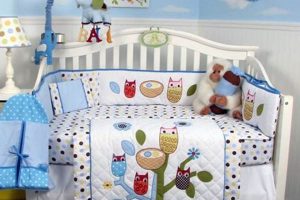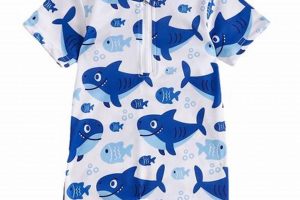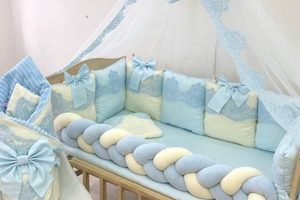A garment designed to protect infants and toddlers from cold weather conditions, this outwear provides insulation and shields against wind, rain, and snow during the winter months. These items typically feature closures such as zippers, buttons, or snaps, and may include a hood for added protection. Examples include puffer jackets, parkas, and fleece-lined outer layers tailored for young children.
Ensuring a young child remains warm and comfortable in frigid temperatures is essential for health and well-being. Adequate protection prevents hypothermia and frostbite, while allowing for safe outdoor activity during colder seasons. Historically, parents have sought methods to safeguard their children from the elements, leading to the development of specialized clothing designed for thermal regulation and comfort.
The following sections will detail specific features to consider when selecting appropriate protective outwear, including material composition, sizing guidelines, and safety standards. Attention will also be given to practical considerations for maintaining the garment’s integrity and ensuring its long-term suitability for a growing child.
Selecting Infant and Toddler Cold-Weather Outerwear
The following recommendations address key considerations for choosing suitable protective outerwear for young children during winter months. Implementing these guidelines promotes child safety, comfort, and optimal thermal regulation.
Tip 1: Prioritize Insulating Materials: Opt for outerwear constructed from materials such as down, fleece, or synthetic fills known for their high insulation-to-weight ratio. This ensures warmth without excessive bulk or restriction of movement.
Tip 2: Evaluate Closure Mechanisms: Select outerwear with secure and easy-to-operate closures such as zippers with storm flaps or large snaps. Avoid closures with small parts that present a choking hazard.
Tip 3: Assess Hood Design and Attachment: Choose a hood that fits snugly around the child’s head and face, offering adequate coverage without obstructing vision. Detachable hoods provide added safety in case of entanglement.
Tip 4: Consider Water Resistance and Windproofing: Look for outerwear with water-resistant or waterproof outer layers to protect against rain and snow. Windproof materials further enhance thermal protection by preventing wind chill.
Tip 5: Ensure Proper Fit and Sizing: Select outerwear that allows for comfortable layering underneath without being excessively large or constricting. Consult sizing charts and consider the child’s growth rate when making a purchase.
Tip 6: Inspect for Safety Features: Verify that the outerwear meets relevant safety standards and regulations. Look for features such as reflective accents to enhance visibility in low-light conditions.
Tip 7: Easy to Clean: Children get dirty, consider a coat that can be cleaned easily in your washing machine.
Adhering to these tips enables informed decisions regarding the selection of infant and toddler cold-weather outerwear, prioritizing safety, comfort, and effective thermal protection during the winter season.
The subsequent section provides details on proper care and maintenance protocols for prolonging the lifespan of protective outerwear and ensuring its continued effectiveness.
1. Warmth
The provision of warmth is a primary function of outerwear intended for infants and toddlers during winter months. Failure to maintain adequate body temperature can result in hypothermia, a potentially life-threatening condition. The effectiveness of a garment in retaining body heat is directly influenced by its insulating properties, construction, and fit. For example, a poorly fitted garment, even with adequate insulation, may allow for heat loss through convection. Conversely, tightly fitted garments may restrict movement and reduce the insulating effectiveness of inner layers.
Material composition plays a crucial role in determining the warmth factor. Natural materials such as down offer exceptional warmth-to-weight ratios. However, down loses its insulating properties when wet. Synthetic insulation, while often heavier, maintains its effectiveness in damp conditions. Garment construction, including features such as quilted baffling and storm flaps, minimizes heat loss through conduction and convection. Consider an infant in a stroller exposed to frigid winds; the ability of the chosen outerwear to maintain a stable core temperature is paramount to prevent cold stress. Similarly, a toddler actively playing outdoors requires a breathable garment to prevent overheating during periods of exertion.
The relationship between appropriate thermal regulation and outerwear selection is crucial for the well-being of infants and toddlers. Selecting garments that provide adequate warmth while accounting for environmental conditions and activity levels remains essential. Overestimation or underestimation of the required insulation can have adverse health consequences. Parents and caregivers must prioritize understanding the thermal properties of various materials and constructions to make informed purchasing decisions. Further research into advanced insulating materials is ongoing, aiming to enhance comfort and protection in extreme cold weather environments.
2. Safety
The selection of appropriate outerwear for infants and toddlers necessitates a paramount focus on safety. Potential hazards associated with cold-weather garments can range from suffocation risks to thermal injuries. Design features, material choices, and fit all contribute to or detract from the overall safety profile of the item. Cause-and-effect relationships are readily apparent: loosely attached embellishments present a choking hazard; drawstrings around the neck pose a strangulation risk. The presence of non-breathable materials can lead to overheating and subsequent discomfort or even heatstroke under certain conditions. For instance, a young child left unattended in a car wearing excessively insulated outerwear may experience a rapid increase in body temperature, highlighting the importance of parental oversight.
Practical application of safety considerations involves meticulous examination of garment details. Closures, such as zippers and snaps, must be robust and free from easily detachable parts. Reflective elements integrated into the outerwear increase visibility in low-light conditions, reducing the risk of pedestrian accidents. Proper sizing is critical; overly bulky garments restrict movement and may impede a child’s ability to navigate their environment safely. Furthermore, materials must be free from toxic substances and conform to relevant safety standards and regulations. One example involves the use of flame-retardant chemicals, which, while intended to enhance safety, can pose health risks if present in excessive concentrations. Selecting garments certified by reputable testing organizations mitigates this risk.
In summary, safety is an inextricable component of appropriate outerwear for infants and toddlers. Diligent assessment of design features, material composition, and fit serves to minimize potential hazards and promote child well-being. Challenges include navigating the complexities of safety standards and the potential for conflicting information. Continuous vigilance and informed purchasing decisions are essential for ensuring that cold-weather garments provide both thermal protection and a secure environment for young children.
3. Comfort
The perceived comfort associated with infant and toddler outerwear directly impacts compliance and, consequently, the effectiveness of the garment in providing thermal protection. Discomfort, stemming from factors such as restrictive fit, abrasive materials, or inadequate breathability, can lead to resistance from the child, resulting in removal of the garment and increased exposure to cold. A causal relationship exists between comfort levels and the duration for which the protective layer remains in place. Examples include a toddler resisting a stiff, heavily padded coat in favor of greater freedom of movement, or an infant experiencing skin irritation from rough fabric, leading to fussiness and attempts to remove the offending item. Therefore, comfort must be considered a crucial design and selection parameter.
Achieving optimal comfort necessitates careful consideration of fabric selection and construction techniques. Soft, non-irritating materials such as fleece or finely woven cotton linings minimize skin contact discomfort. Strategic placement of seams and closures prevents chafing and pressure points. Sufficient ease of movement allows for unrestricted activity without compromising thermal insulation. Practical applications of these principles include selecting a coat with articulated sleeves for enhanced mobility or choosing a style with a smooth, tagless neckline to reduce irritation. Furthermore, the breathability of the garment is paramount; excessive insulation without adequate ventilation can lead to overheating and moisture buildup, creating a damp and uncomfortable environment. Consequently, the benefits of thermal protection are diminished if comfort is not adequately addressed.
In summation, comfort represents a critical, yet often underemphasized, component of appropriate outerwear selection for infants and toddlers. Challenges arise in balancing the need for thermal protection with the imperative of unrestricted movement and skin sensitivity. Understanding the interrelationship between garment design, material properties, and the child’s sensory experience allows for informed purchasing decisions, ultimately maximizing the effectiveness and acceptance of cold-weather outerwear. Neglecting the comfort factor increases the likelihood of non-compliance, undermining the intended benefits of thermal regulation and protection against the elements.
4. Durability
Durability, pertaining to infant and toddler outerwear, is a key attribute that dictates the lifespan and overall value proposition of the garment. Given the growth rate of young children and the frequency with which outerwear is subjected to wear and tear, resistance to damage and degradation becomes a primary consideration for responsible purchasing decisions. The following explores critical facets of durability in the context of cold-weather protective wear.
- Material Resistance to Abrasion
The inherent ability of the fabric to withstand rubbing and friction is a determinant of long-term usability. Reinforced elbows and knees on outerwear, for instance, counteract wear in high-contact areas. Inferior materials abrade easily, resulting in thinning, tears, and diminished thermal performance. Durable materials such as tightly woven nylon or treated canvas prolong the functional life of the garment.
- Seam Strength and Stitching Quality
The integrity of seams is crucial for maintaining the structural integrity of the outerwear. Weak or poorly stitched seams are prone to separation, leading to gaps in insulation and reduced weather protection. Reinforced stitching, double seams, and high-quality thread enhance seam strength and prolong the garment’s lifespan. Improper seam construction often results in premature failure under stress.
- Hardware Resilience
Components such as zippers, snaps, and buttons are susceptible to damage and breakage. Robust, high-quality hardware ensures secure closures and reliable functionality. Substandard zippers may jam or break, rendering the outerwear unusable. Similarly, flimsy snaps and buttons may detach easily, compromising the garment’s protective capabilities. Metal hardware often demonstrates superior durability compared to plastic alternatives.
- Resistance to Environmental Degradation
Prolonged exposure to sunlight, moisture, and temperature fluctuations can degrade materials, leading to fading, cracking, and loss of elasticity. Fabrics treated with UV inhibitors and water-repellent finishes exhibit enhanced resistance to environmental damage. Improper storage or cleaning practices can accelerate material degradation, reducing the overall lifespan of the outerwear. Protecting the garment from prolonged exposure to harsh elements preserves its integrity.
Integrating durable materials, robust construction techniques, and resilient hardware extends the usability of outwear, ultimately providing a cost-effective solution. The selection of durable baby boy winter coat options minimizes replacement frequency, reducing both environmental impact and financial burden. A robust garment effectively withstands the rigors of repeated use. This ensures that the investment remains functional and relevant throughout the intended duration of wear.
5. Sizing
Appropriate sizing is a crucial determinant in the effectiveness of a “baby boy winter coat,” influencing thermal regulation, mobility, and overall safety. An improperly sized garment can impede a child’s movement, restrict blood circulation, and compromise the insulating properties of the material. For example, a coat that is too large may allow cold air to penetrate, diminishing its ability to retain body heat, whereas a coat that is too small may restrict movement, making physical activities cumbersome and uncomfortable. This causal relationship between sizing and functionality underscores the importance of accurate measurements and informed purchasing decisions.
Practical applications of understanding sizing considerations include consulting manufacturer-provided size charts, which typically correlate height, weight, and chest measurements to garment dimensions. However, these charts should serve as guidelines rather than definitive measures, as variations in body proportions and garment construction can influence fit. It is recommended to allow for sufficient room to accommodate layering underneath the coat, without creating excessive bulk that could hinder movement. A real-life example would be adding an additional one to two inches to the chest measurement when selecting a coat, permitting the comfortable wearing of sweaters or other insulating layers. This practical adjustment ensures that the child remains warm without sacrificing mobility.
In summary, the connection between appropriate sizing and the functionality of cold-weather outerwear is undeniable. Challenges arise in navigating the inconsistencies across manufacturers’ sizing standards and accounting for individual variations in body proportions. The integration of precise measurements, awareness of layering needs, and consideration of garment construction yields a superior outcome in the selection process. Accurately sized outerwear maximizes thermal efficiency, promotes freedom of movement, and contributes significantly to the safety and well-being of the child during winter months. Prioritizing suitable sizing promotes thermal protection and comfort.
6. Materials
The selection of appropriate materials is paramount to the functionality and suitability of outerwear designed for infant and toddler boys during winter. Fabric composition directly impacts thermal regulation, durability, safety, and overall comfort, necessitating careful consideration of material properties and construction techniques.
- Insulation Materials: Thermal Properties and Performance
Insulation materials dictate the garment’s ability to retain heat and protect against cold. Down, a natural insulator, offers excellent warmth-to-weight ratio but loses effectiveness when wet. Synthetic alternatives, such as polyester fibers, maintain insulating properties in damp conditions, though they may be bulkier. A real-world application involves choosing a down-filled coat for dry, cold climates and a synthetic-filled coat for wet, snowy conditions. The selection hinges on balancing thermal performance with environmental factors.
- Outer Shell Fabrics: Weather Resistance and Durability
The outer shell fabric shields the child from wind, rain, and snow, necessitating water resistance and durability. Tightly woven nylon or polyester fabrics, often treated with water-repellent finishes, provide protection against the elements. Reinforcements in high-wear areas, such as elbows and knees, enhance durability. A practical example is a toddler actively playing outdoors; a durable outer shell prevents tearing and maintains the garment’s integrity despite abrasive contact with surfaces.
- Lining Materials: Comfort and Breathability
The lining material comes into direct contact with the child’s skin, impacting comfort and breathability. Soft, non-irritating fabrics, such as fleece or cotton blends, minimize skin irritation. Breathable linings facilitate moisture evaporation, preventing overheating and discomfort. An illustrative scenario is a young infant prone to skin sensitivities; selecting a coat with a hypoallergenic lining minimizes the risk of irritation and promotes comfort.
- Closure and Trim Materials: Safety and Functionality
Materials used for closures, such as zippers, snaps, and buttons, must be robust and free from small, detachable parts that pose a choking hazard. Reflective materials enhance visibility in low-light conditions, improving safety. The selection of durable, non-toxic materials for these components is essential. Consider the case of a coat with a zipper that breaks easily; this compromises both functionality and safety, underscoring the importance of quality materials.
These considerations collectively underscore the critical role of material selection in the design and performance of outerwear for young children. Careful assessment of material properties, balanced with practical application scenarios, enables informed purchasing decisions, prioritizing safety, comfort, and effective thermal protection.
7. Features
The specific attributes incorporated into the design and construction of a “baby boy winter coat” exert a substantial influence on its functionality, safety, and overall suitability for protecting infants and toddlers from cold weather conditions. These features extend beyond basic insulation and encompass elements that enhance usability, ensure comfort, and address potential safety concerns.
- Hood Design and Attachment
The hood serves as a critical component in protecting the head and neck from cold, wind, and precipitation. Hood design varies, including attached, detachable, and stowable options. A snug-fitting hood with an adjustable drawcord or elasticized opening provides optimal protection. Detachable hoods enhance safety by minimizing the risk of entanglement. A real-world example is a hood with a faux fur trim, which, while aesthetically pleasing, can obstruct vision if not properly designed and positioned.
- Closure Systems and Wind Flaps
Closure systems, such as zippers, snaps, or buttons, secure the coat and prevent cold air from entering. Wind flaps, positioned behind or over the closure, further enhance thermal protection by blocking wind penetration. Zipper guards, designed to prevent pinching, improve safety. The selection of a robust and easy-to-operate closure system is essential for practicality. For instance, a coat with a heavy-duty zipper and a snap-closure wind flap offers superior protection compared to a coat with a lightweight zipper and no wind flap.
- Pocket Placement and Functionality
Pockets offer convenient storage for small items, such as gloves or pacifiers. Placement and design impact both functionality and safety. Pockets positioned too low may be difficult for a child to reach, while pockets with loose flaps or closures may pose a safety hazard. Securely fastened pockets with sufficient capacity enhance usability. Consider a coat with fleece-lined handwarmer pockets, which provide added comfort and warmth in cold weather.
- Reflective Elements and Visibility Enhancement
Reflective elements, such as strips or patches, enhance visibility in low-light conditions, improving safety. Strategic placement of reflective materials on the sleeves, back, and hood increases the child’s visibility to motorists and pedestrians. A practical example is a coat with 360-degree reflective coverage, which significantly improves visibility during nighttime or inclement weather conditions. This feature is particularly important for children walking to school or playing near roadways.
These features demonstrate the multifaceted nature of outerwear design for infant and toddler boys. Effective winter protection necessitates attention to detail, prioritizing both practical functionality and safety considerations. The interplay between design elements ensures suitability and thermal protection.
Frequently Asked Questions
The following section addresses common inquiries and concerns pertaining to the selection and use of cold-weather outerwear for infant and toddler boys, providing factual information for informed decision-making.
Question 1: At what temperature is a winter coat necessary for an infant?
Generally, when temperatures drop below 65 degrees Fahrenheit (approximately 18 degrees Celsius), a winter coat is advisable for infants. However, factors such as wind chill and humidity should also be considered. Observe the child for signs of cold, such as shivering or cool extremities.
Question 2: How should a winter coat fit an infant or toddler for optimal safety and comfort?
The coat should allow for layering of clothing underneath without being overly bulky or restrictive. Ensure the sleeves are of appropriate length, and the coat should close securely without gaps. A snug but not constricting fit promotes both warmth and freedom of movement.
Question 3: What are the safest types of closures for a baby’s winter coat?
Zippers with fabric guards and snap closures are generally considered safe, provided they are robust and free from small, detachable parts. Avoid coats with drawstrings around the neck, as these present a strangulation hazard. Regularly inspect closures for damage.
Question 4: How often should a baby’s winter coat be cleaned?
Cleaning frequency depends on usage and exposure to dirt or contaminants. Spot clean as needed and wash the coat according to the manufacturer’s instructions. Frequent washing may degrade the material, so adhere to recommended cleaning protocols.
Question 5: Is it safe for a baby to wear a winter coat in a car seat?
Bulky winter coats can compress in a car seat crash, creating excess space under the harness, and a child could slip through the straps. Remove the coat and secure the child tightly. Alternatively, layer clothing and cover them with the coat or blanket after the harness is secured.
Question 6: What materials are best for a baby’s winter coat to provide warmth and weather resistance?
Down or synthetic insulation provides warmth. Outer shell fabrics such as nylon or polyester with a water-repellent finish provide weather resistance. The inner lining should be soft and non-irritating, such as fleece or cotton blends.
Understanding these common concerns regarding winter outerwear for young children enables parents and caregivers to prioritize safety and comfort in selecting appropriate garments.
The subsequent section outlines key considerations for ensuring the continued safety and effectiveness of infant and toddler winter coats through proper care and maintenance procedures.
Baby Boy Winter Coat
The preceding exploration has elucidated critical aspects of protective outerwear designed for infant and toddler boys during winter months. Salient points encompass material selection, construction techniques, sizing considerations, safety features, and maintenance protocols. Adherence to these guidelines is crucial for safeguarding children from the adverse effects of cold temperatures.
Selecting appropriate cold-weather garments demands meticulous attention to detail and a commitment to informed purchasing decisions. The well-being of young children relies on the diligence of caregivers in prioritizing safety, comfort, and thermal protection. Continued vigilance and adherence to best practices represent the most effective means of ensuring the health and security of infants and toddlers throughout the winter season.







